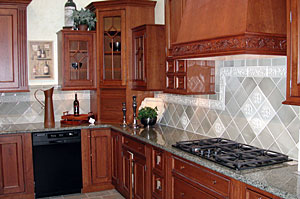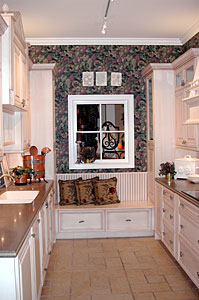| |
 |
 |
Build us some cabinets from hand-lacquered
Ash
Raised panel doors, a niche for our trash.
Ball-bearing glides that roll smooth as
silk
A place for the sponge to clean up spilled milk.
The sky's the limit when it comes to our
taste
It's money well spent. Who says it's a waste!
|
Like all aspects of home remodeling and new construction, the quality
and price range of kitchen and bathroom cabinets are as varied as can be.
Depending on the cabinet construction, wood species, quality of hardware,
and custom options, the price for cabinets in a moderately sized kitchen
(say 30 lineal feet) can range from $6,000 to over $35,000 - a spread of
six to one. Since some of the differences are not readily visible at first
glance, the following discussion should help you to become an enlightened
cabinet shopper. Asking the right questions and grilling the sales staff
will show that you're a serious buyer who will accept no less that quality
workmanship and structural integrity.
Framed or Frameless?
There are basically two styles of cabinet boxes available: those with
face frames and those without. A face frame provides a continuous
perimeter face (typically 3/4" thick by 1-1/2" wide) that
greatly enhances the cabinet rigidity and structural integrity. Depending
on the manufacturer, the face frame is dadoed and secured onto the cabinet
edges with wood glue and screws. Higher grade cabinets may actually offer
a mitered, interlocking corner detail such as the "Miracle
Corner" found in a line of cabinets from Quakermaid. Such a joint
detail provides a very strong seamless intersection between the cabinet
sides and the face frame itself.
Cabinets with face frames offer the most traditional appearance. Due to
their superior rigidity, they also hold their squareness better than their
frameless counterparts. Their dimensional stability minimizes damage
during shipment from the manufacturer and reduces in-service adjustment of
doors. Installation time is also less, sometime as much as 50% lower. This
could save you hundreds of dollars in labor for a typical kitchen
installation. In my discussions with numerous cabinet suppliers and
installers, I heard consistent comments that time is beginning to show
that frameless cabinets do not fare well in areas subjected to expansive
soils or periodic earthquakes. After a few years, the cabinets come out of
alignment requiring tedious readjustment of doors, hinges and mountings.
The higher callback ratio for frameless cabinets is reflected up front in
higher installation costs.
With all the apparent disadvantages of frameless cabinets, why would
anyone want them? Quite simply it comes down to styling. A frameless
cabinet has a very modern sleek appearance, especially with some of the
newer European-style laminates. Furthermore, eliminating the face frame
provides better access to interior sections since there is no face frame
to obstruct your reach. Specially designed European hinges can be
concealed from view, providing a full overlay exterior door that has a
clean, sleek, modern appearance.
These slight advantages, however, are more than offset by their bigger
disadvantages. For example, if you like the clean look of a full overlay
door with concealed hinges but insist on face frames for structural
rigidity, a number of quality manufacturers now offer lines of European
hinges with special face-frame mounting bases. In some cases, the hinge
readily detaches from the base making door removal a snap. This is a big
benefit during installation as the doors often account for up to 30% of
the cabinet weight. Taking them off for safe keeping during installation
and general construction helps to minimize damage by other trades.
Some of my favorite door hinges are manufactured by Grass America, a
domestic subsidiary of an Austrian firm specializing in European concealed
hinges. Not only does Grass offer a wide selection of hinge types, but
their construction is all metal (die cast zinc or steel) with no plastic
parts as found on many look-alike products. Grass also manufacturers a
176-degree double-pivot hinge that allows cabinet doors to swing fully
open, just shy of adjacent door panels. Since many European concealed
hinges have only a 100-degree opening radius, cabinet members could be
damaged if the doors were forced beyond their prescribed amount. For
example, you might open a base cabinet to retrieve an item, and you
accidentally ram your knee against the door, pushing it back with great
force. You hear a crack and realize you split the face frame or cabinet
door. Other manufacturers such as Blum and Mepla also make European hinges
of high quality.
Cabinet Doors
Cabinet doors come in varied styles and thicknesses. Many are
3/4" thick, with premium doors being 7/8" or thicker.
While the thicker door is not a structural requirement, it allows for more
substantial face detailing. Since many custom cabinet makers
purchase their doors and drawer fronts from large national producers, you
shouldn't be limited in your choice of styles or woods. Typical
woods used in cabinets include Oak, Cherry, Birch, Maple, and Ash.
Each has their own distinctive color, grain, and feel.
Drawer Slides
Good cabinet manufacturers now offer a selection of drawer glides as
well as hinge types. Accuride of El Monte, California, has earned a
reputation for its ball-bearing side-mount drawer glides. If you're into
sexy feeling, there's no mistaking an Accuride drawer glide. Heavy metal
tracks house lubricated rows of steel ball bearings that provide
exceptional smoothness, longevity, and weight capacity. Some of Accuride's
drawer glides are also available with an acetal polymer ball bearing that
will never rust or lose its smoothness. Full extension drawer glides are
also available, making it easy to extend a drawer its full length for
maximum access and easy cleaning. Grass America also offers an excellent
drawer glide based on a nylon roller and epoxy-coated steel track. Novel
features include feather-touch closing, shock-absorbing closing, and
detents. A number of other manufacturers also offer quality drawer glides.
Another consideration is the load bearing amount. Some cheaper glides
can only handle 50 pounds or less. For roll out shelves loaded with heavy
cookware, these may fail to provide the expected strength and smoothness
of operation over extended periods of time. For extra weight capacity,
drawer glides are available for weights in excess of 100 lb., similar to
those used on filing cabinet drawers.
In general, drawer glides are either side mount or bottom mount. Side
mount glides have the disadvantage that they require an extra inch or so
of space, taking it out of the drawer width. This may not be a problem in
a wide drawer, but may become objectionable in a particularly narrow
drawer, such as a 12" drawer. Some people don't like the looks of the
side mount glides, which are generally available in a white or ivory epoxy
finish or a bright zinc or black zinc finish.
Bottom mount glides are unobtrusive to the eye, but they take valuable
space out of the drawer height. This, too, could be objectionable
depending on the drawer height. In general, where heavy loads are
expected, side mount glides out-perform bottom mount glides. Either way,
it really comes down to personal preference. Whatever you do, don't choose
glides with a single track down the bottom center of the drawer. These
just never seem to glide freely or stay well balanced under different
drawer loading conditions.
The quality of cabinet construction, hardware, and number of options
largely determine the overall cost of the cabinet. If you can use standard
sizes and are satisfied with a more limited selection of wood types and
finishes, you’ll save a considerable sum by selecting a manufacturer
that offers few options. On the other hand, if you require custom depths,
heights, options, and finishes, you can find these too, but you'll pay
more per running foot because of the added overhead and machinery the
manufacturer must maintain to offer a wider selection of options. Don't be
fooled, however. If you do your shopping, you might stumble upon a custom
cabinet maker who can provide "custom" features at a price
competitive with modular factory-built cabinets.
In general, a well built cabinet will be all wood construction. Many
low-end grades are built from laminated particle board. Although beware
that not all cabinets made from laminated particle board are necessarily
inexpensive; some of the most stylish (and expensive) cabinets I've seen
are, in fact, made from plasticized particle board. Higher grade cabinets,
however, are manufactured from veneered plywood frames with solid wood
face frames and doors. Medium-grade cabinets use a combination of plywood
and particleboard construction to moderate costs accordingly.
Look for the following features in a well-built cabinet:
- Doors: minimum 3/4" thick solid wood, 7/8" or thicker
preferred
- Face Frames: 3/4" x 1-1/2" solid wood
- Backs and sides: 1/2" min. plywood, veneered with maple or
birch on interior
- 3/4" thick veneered plywood shelves for lengths up to 36
inches, with 1" thick plywood shelves on lengths up to 48".
A decorative and structural face band should be added to prevent
warping or sagging over time.
- Drawers: 1/2" min. thickness, 5/8" or 3/4" preferred
for added elegance and strength. Solid maple or birch dovetailed or
glued and doweled at all four corners, 1/4" min. thickness
bottoms
- Typical Wood Species: Red Oak, Birch, Cherry, Ash, Maple, Pine
Selecting the Wood Species
Selecting the wood species depends largely on your taste and your
budget. Common woods include Red Oak, Birch, Ash, Hard Maple, and Cherry.
Other woods may also be suitable, such as knotty pine, but with softer
characteristics that may make them more prone to cosmetic damage and
scaring. Other woods, such as Walnut, make beautiful cabinets, but their
cost may be prohibitive. Oak is known for its excellent durability,
heavy-grained appearance. Whitewashed Oak and Maple have been in and out
of popularity, but is likely to be a trendy fashion that may go out of
vogue in five years. Birch is less hard than Oak, but has a tighter grain
and looks good with light to medium stains and finishes.
One of the most elegant, richest looking woods is Cherry. Naturally a
reddish-brown color, Cherry takes stain very well and provides a rich,
intense look that never gets tiring. Because Cherry is less hard than Oak,
it will be subject to more nicks and scratches over time -- a
consideration if you have young children who might drive their tricycles
wantonly into your kitchen cabinets. Because of its relative rarity,
Cherry carriers a price premium of 10% - 15% price premium in the finished
product over Oak. That means that an identical kitchen that's $15,000 in
Oak is likely to cost about $17,000 in Cherry. This can amount to a $1,000
- $2,000 surcharge for a typical custom kitchen. Birch can be stained
dark, but its grain appears more feathered and doesn't have the same
richness as Cherry.
Frankly, there's no more beautiful cabinet than Cherry finished with a
neutral stain and clear satin lacquer. The subtle grain and rich
warmth of Cherry brings a kitchen alive. When paired with stainless
steel appliances and granite countertops, you'll have a dream kitchen
worthy of a Better Homes and Gardens centerfold.
|
